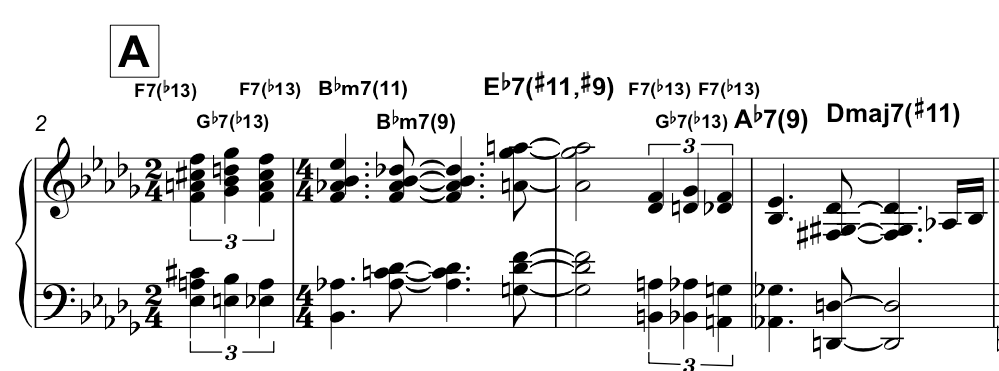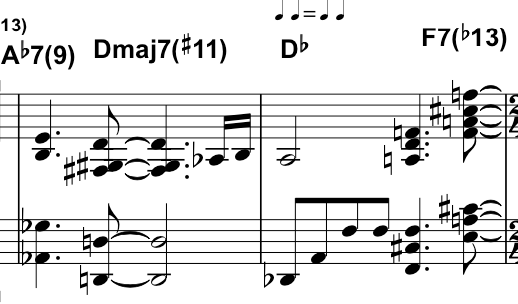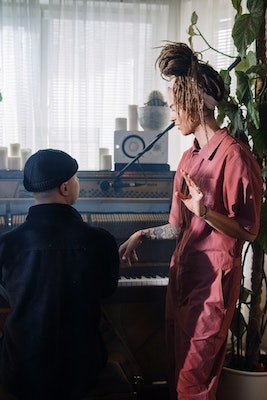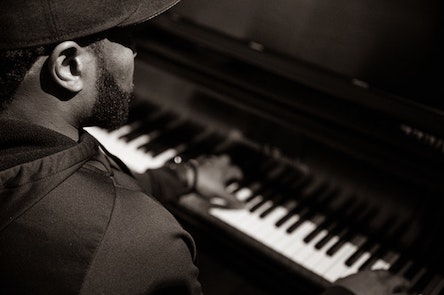Isn’t She Lovely Piano Lesson: Analyzing Ben Paterson
 We’re excited to announce that we’ve just added superstar Ben Paterson to our 1 on 1 jazz faculty in the Jazz Inner Circle.
We’re excited to announce that we’ve just added superstar Ben Paterson to our 1 on 1 jazz faculty in the Jazz Inner Circle.
To celebrate we’ll take a look at 2018 Ellis Marsalis International Jazz Piano Competition winner Ben Paterson’s excellent take on a Stevie Wonder classic.
Let’s get started.
Isn’t She Lovely Piano Performance By Ben Paterson
Before we go into the lesson itself, take 4 minutes to appreciate Ben Paterson’s masterful treatment of Stevie Wonder’s Isn’t She Lovely:
Now that you have listen to Ben’s take on the tune, let’s dig deeper:
How To Grab Listener Attention Like Ben Paterson
To set the tone as well as establish the key of the piece, Ben plays this quick run:

 Ben starts this bar by playing an F in the bass followed by a rootless F7(b13) chord.
Ben starts this bar by playing an F in the bass followed by a rootless F7(b13) chord.
After that, you have this rapid F augmented triad arpeggio.
To play the arpeggio, simply use fingers 1, 2, 3, and 5 over the chord shape and repeat over 3 octaves going up.
Now let’s look into how to work on Isn’t She Lovely piano harmonies Ben’s way.
One Secret To Creating Excitement On A Classic Tune
Take a look at how Ben harmonizes the first phrase of Isn’t She Lovely:

The first 3 notes of bar 2 are F and Gb.
 Because they’re just a half step apart, you can use a chromatic passing chord over Gb (Gb7b13) and then go back to F7(b13) to harmonize the melody.
Because they’re just a half step apart, you can use a chromatic passing chord over Gb (Gb7b13) and then go back to F7(b13) to harmonize the melody.
On bar 3, play a Bbm7(11) chord just like Ben.
Notice that on the 1st beat of bar 3, you have a left hand shell voicing. On the “& of 2”, play a rootless Bbm7(9) as shown in the notation.
Ben Paterson also loves to use a lot of extensions over his chord voicings to add texture and excitement.
Bar 4 features a chromatic walkdown going to the V chord.
The next section reveals how you can use reharmonization to spice up any tune.
How Ben Paterson Uses Tritone Substitutions On His Isn’t She Lovely Piano Arrangement
One of the most useful ways of reharmonization is using tritone chord substitution.
On bar 5, Ben plays both the standard V chord (Ab7) and then this is followed by a chord substitution (Dmaj7#11) that resolves to the I chord on the next bar.

Before the reharm, Ben still plays the V chord on the 1st beat.
He then plays the tritone substitute at the & of 2 for a more pronounced effect.
Now, let’s see how you can add a bit of flash just the way Ben does it.
How To Play A Short, Quick, Bluesy Run Like Ben
Bar 11 of this Ben Paterson arrangement features a quick, staccatissimo run over a Db major chord:

This particular run appears to be based on the F minor blues scale with a chromatic run in the end after the 5th.
 Practice the run as follows:
Practice the run as follows:
- Use the fingering 1-2-3-4 for F-Ab-Bb-Cb.
- Run through C-Db-D-Eb-E using 1-2-2-3-4. Finger 2 easily slides off from Db to D using that sliding finger technique in blues.
- Go through the run very slowly at first with proper staccatissimo articulation.
- Once it can be executed at a particular slow tempo, increase speed in just small increments.
You can also use this scale pattern as an exercise by playing it up and down.
Proper fingering for the descending version involves sliding the 3rd finger placed on Eb down to E natural.
Now let’s take a look at how Ben adds a bit more modern flavor to his piano arrangement.
How To End An Isn’t She Lovely Piano Chorus With More Interesting, Modern Harmonies
On bars 16 to 19, Ben plays some really interesting chord voicings to harmonize the melody.

 Bar 16 features add9 chords made up of the root and 5th in the left hand and the 9th and 5th for the right hand.
Bar 16 features add9 chords made up of the root and 5th in the left hand and the 9th and 5th for the right hand.
These chords are essentially stacks of 5ths and 4ths.
Bar 17 has chords consisting of the root and 5th for the left hand then a 9th and #11th for the right.
We see the end of the passage with a Cb6/9 chord as a substitute for what’s supposed to be a Dbmaj7 chord.
Now that you know some of Ben Paterson’s tricks, what should you do next?
Why You Feel Stuck Musically (And What To Do About It)
 Do feel like you’re making a fool out of yourself every time you play?
Do feel like you’re making a fool out of yourself every time you play?
You may have studyied all sorts of techniques, tips, and tricks from YouTube.
You might have gone through a vast library of music lessons.
However, when push comes to shove, you’re still unhappy with your playing.
Despite how much you love music, it’s not fun to feel embarrassed or unhappy about a performance.
Perhaps, you just don’t have the right focus and guidance.
It’s a good thing that the Jazz Inner Circle is here to help.
 The Jazz Inner Circle features critically acclaimed, award-winning, world-touring instructors like Ben Paterson himself.
The Jazz Inner Circle features critically acclaimed, award-winning, world-touring instructors like Ben Paterson himself.
Our world-class jazz piano instructors definitely know what it takes for you to be taken seriously and hit the stage with confidence.
Inside the Jazz Inner Circle, you’ll discover:
- Over 50 hours of high-level jazz intensive workshops.
- One-on-one training sessions with award-winning, Grammy nominee, and world touring piano instructors.
- “The Jazz Piano Mastery Program”
Slots are very limited, so I strongly recommend booking for an interview ASAP.
I hope you enjoyed this lesson looking into Ben Paterson’s Isn’t She Lovely piano arrangement.
If you have any suggestions, questions, or comments, feel free to leave some below. We’d love to hear from you.
Happy practicing.
